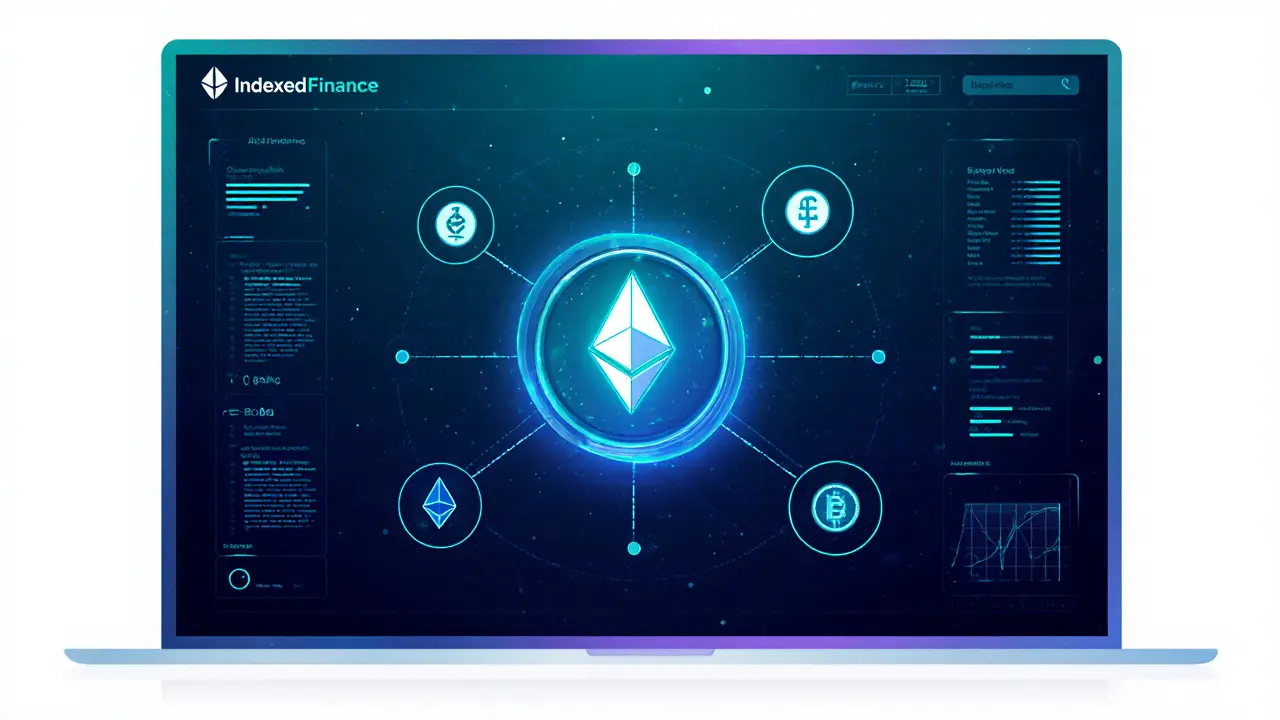NDX Liquidity Impact Calculator
Trade Impact Calculator
Enter your trade amount to see how much slippage you'd experience given NDX's current liquidity levels.
Estimated slippage based on:
• Current price: $0.0041
• 24-hour volume: $21
• Circulating supply: 3.44M NDX
Key Takeaways
- Indexed Finance is a DeFi protocol on Ethereum that lets you mint, burn and swap tokenized index funds.
- Its native governance token, NDX, has a max supply of 10 million but a circulating supply under 4 million.
- Market cap hovers between $3,000 and $15,000, with daily volume below $30, making liquidity a major concern.
- The protocol’s unique selling point is a dynamic, capitalization‑weighted index pool that rebalances without external liquidity.
- Compared with larger index projects like Index Coop, Indexed Finance shows minimal adoption and limited community support.
Ever wonder why a crypto project can exist on Ethereum yet barely move the needle on price charts? Indexed Finance is a perfect case study - a lofty idea wrapped inside an almost invisible token. Below we break down what Indexed Finance (NDX) actually does, how its tech works, why its market numbers matter, and what risks you should weigh before touching the token.
When you see Indexed Finance (NDX) is a decentralized finance (DeFi) project focused on passive portfolio management on the Ethereum network. The protocol lets users create and trade tokenized index funds that mimic traditional market‑cap weighted indexes. Founded in 2020 by Dillion Kellar and an anonymous developer known as PR0, the team now numbers five core contributors. The platform’s native token, NDX, functions solely as a governance token - holders vote on protocol upgrades, new index definitions, and high‑level strategy changes.
What Is the NDX Token?
NDX is an ERC‑20 token with a hard‑capped supply of 10 million. Around 3.4 million tokens are reported as circulating, representing roughly one‑third of the total supply. Its price has hovered between $0.0023 and $0.0108 since launch, with a current trading price of about $0.0041 (October 2025 data from various aggregators). The token does not pay staking rewards or share protocol fees - its only utility is voting power.
How Indexed Finance Works: Index Pools
The heart of the protocol is the Index Pool contract. Each pool represents a capital‑weighted basket of underlying assets, such as ETH, USDC, or other ERC‑20 tokens. Users can interact with a pool in three ways:
- Minting: Deposit the required amounts of each underlying asset, and receive an equivalent amount of the pool’s ERC‑20 index token.
- Burning: Return the index token to the pool and claim the underlying assets in the current weight ratios.
- Swapping: Trade the index token on decentralized exchanges (e.g., SushiSwap, Bancor V2) for instant exposure.
What makes Indexed Finance different from a regular AMM is the ability to change the pool’s composition without pulling in external liquidity. The modified Index Pool contract can gradually re‑weight assets, a process the team calls “binding, rebounding, and reweighing.” This eliminates the need for a separate liquidity provisioning step each time the index composition changes.
Governance Mechanics
NDX holders participate in a classic DeFi governance model. Proposals are submitted to the governor contract, and voting periods started at roughly 12 hours (measured in Ethereum blocks) before being extended to about three days after a Jan 7 2021 update. Votes are tallied proportionally to the number of NDX tokens locked for the vote. Because the circulating supply is tiny, a relatively small number of tokens can sway a decision, raising concerns about genuine decentralization.
Market Snapshot (October 2025)
| Metric | Value |
|---|---|
| Current price | $0.0041 |
| Market cap | $14,000 (approx.) |
| 24‑hour volume | $15‑$27 |
| Circulating supply | 3.44 million NDX |
| Fully diluted valuation | $40,700 |
| Rank (by market cap) | #10,400 |
These numbers reveal two critical points: liquidity is vanishingly low, and the token sits far down the market‑cap rankings. For anyone looking to trade or provide governance input, the thin order books on Bancor V2 and SushiSwap mean slippage can easily exceed 5 % for modest order sizes.
How Does Indexed Finance Compare to Other DeFi Index Protocols?
| Feature | Indexed Finance (NDX) | Index Coop (DPI) | TokenSets (SET) |
|---|---|---|---|
| Platform | Ethereum only | Ethereum, Polygon | Ethereum |
| Token type | Governance only | Governance + fee revenue | Governance + set token |
| Liquidity (24 h volume) | $15‑$27 | $200 M+ | $30 M+ |
| Market cap | $14 k | $120 M | $40 M |
| Community size (Telegram) | ~200 members | ~30 k members | ~10 k members |
| Dynamic rebalancing | Yes (no external liquidity) | No (static compositions) | Yes (set manager) |
While Indexed Finance’s dynamic rebalancing is technically clever, the sheer scale gap makes the protocol a niche player. Larger projects not only enjoy deeper liquidity but also generate fee revenue that can be redistributed to token holders - a feature NDX completely lacks.
Step‑By‑Step: Using Indexed Finance
- Set up an Ethereum‑compatible wallet (MetaMask, Trust Wallet, etc.).
- Visit the official Indexed Finance UI and connect your wallet.
- Choose an index pool you want exposure to (e.g., a crypto‑cap weighted index).
- Deposit the required underlying assets. The UI will calculate the exact amounts based on current weights.
- Confirm the transaction - you’ll receive the pool’s ERC‑20 index token.
- To exit, either burn the index token back into the underlying assets or swap it on a DEX like SushiSwap.
- If you hold NDX, navigate to the governance portal, lock your tokens, and vote on active proposals.
Because gas fees on Ethereum can spike, it’s wise to check the current price before minting or burning - a $100 mint could cost $15-$20 in gas during peak periods.

Risks and Criticisms
1. Liquidity risk: With daily volume under $30, even small trades can move price dramatically. 2. Governance concentration: Low circulating supply means a few whales can dominate votes. 3. Security uncertainty: No public audit reports have been released, and the contract is a fork of an unnamed AMM, raising potential vulnerability concerns. 4. Adoption gap: The protocol is listed on only two DEXs and lacks major wallet or exchange integrations. 5. Revenue‑less token: NDX does not earn fees or share protocol profits, limiting upside beyond speculative price moves.
Future Outlook
Since the last documented governance update in early 2021, Indexed Finance has shown little development activity. No roadmap, no new index launches, and a stagnant community suggest the project may be on a slow path to abandonment. However, if the team were to secure a reputable security audit and list the token on larger DEX aggregators, liquidity could improve marginally. Until then, prospective investors should treat NDX as a high‑risk speculative asset.
Frequently Asked Questions
What is the main purpose of Indexed Finance?
Indexed Finance aims to bring traditional, capitalization‑weighted index funds to the Ethereum blockchain, allowing users to mint, burn, or swap a single token that represents a diversified crypto basket.
How can I acquire NDX tokens?
NDX is available on a handful of decentralized exchanges such as SushiSwap and Bancor V2. You’ll need an Ethereum wallet, some ETH for gas, and then you can swap a stablecoin or ETH for NDX.
Does NDX provide any revenue sharing?
No. NDX is a pure governance token; it does not earn fees, staking rewards, or dividend‑style payments.
Is Indexed Finance audited?
Public audit reports have not been released. Users should consider the lack of a third‑party audit a security risk.
Can I create my own index on Indexed Finance?
Only the core development team can launch new index pools. Community members can propose new pools via governance, but final approval requires a successful vote.


1 Responses
In the grand tapestry of decentralized finance, Indexed Finance emerges as a most ambitious yet under‑appreciated experiment, daring to transmute traditional market‑cap weighted indices onto the immutable canvas of Ethereum. Its very architecture, predicated upon dynamic rebalancing without the need for external liquidity, reads like a manifesto for the avant‑garde of token engineering. The protocol’s native token, NDX, while ostensibly a mere governance instrument, secretly embodies the aspirations of a community yearning for true decentralisation, albeit one hamstrung by a paltry circulating supply. One must pause to consider the paradox of a token that commands voting power yet offers no fee revenue, a scenario that courts both idealism and cynicism in equal measure. The market metrics, with a market cap languishing in the low‑four‑figure range and daily volume scarcely breaching three‑figures, paint a portrait of stark illiquidity that would make any seasoned trader shudder. Yet, beyond the sterile numbers, there exists a narrative of technical ingenuity, a proof‑of‑concept that re‑weights assets through a novel binding‑rebounding‑reweighing process. Critics may deride this as mere academic curiosity, but the very existence of such a mechanism underscores the relentless march of innovation within DeFi. Moreover, the governance model, wherein a modest quantum of NDX can tip the scales of proposals, raises profound questions about decentralised power structures and the spectre of whale dominance. The sparsity of community engagement, evidenced by a telegram cohort of merely two hundred souls, further accentuates the project's isolation amidst a sea of bustling protocol ecosystems. Nevertheless, one cannot discount the potential catalytic effect of an external audit or a strategic listing on a prominent DEX aggregator, which might breathe liquidity into the stagnant order books. In sum, Indexed Finance stands at the crossroads of brilliance and obscurity, a testament to both the possibilities and perils of pioneering DeFi constructs.